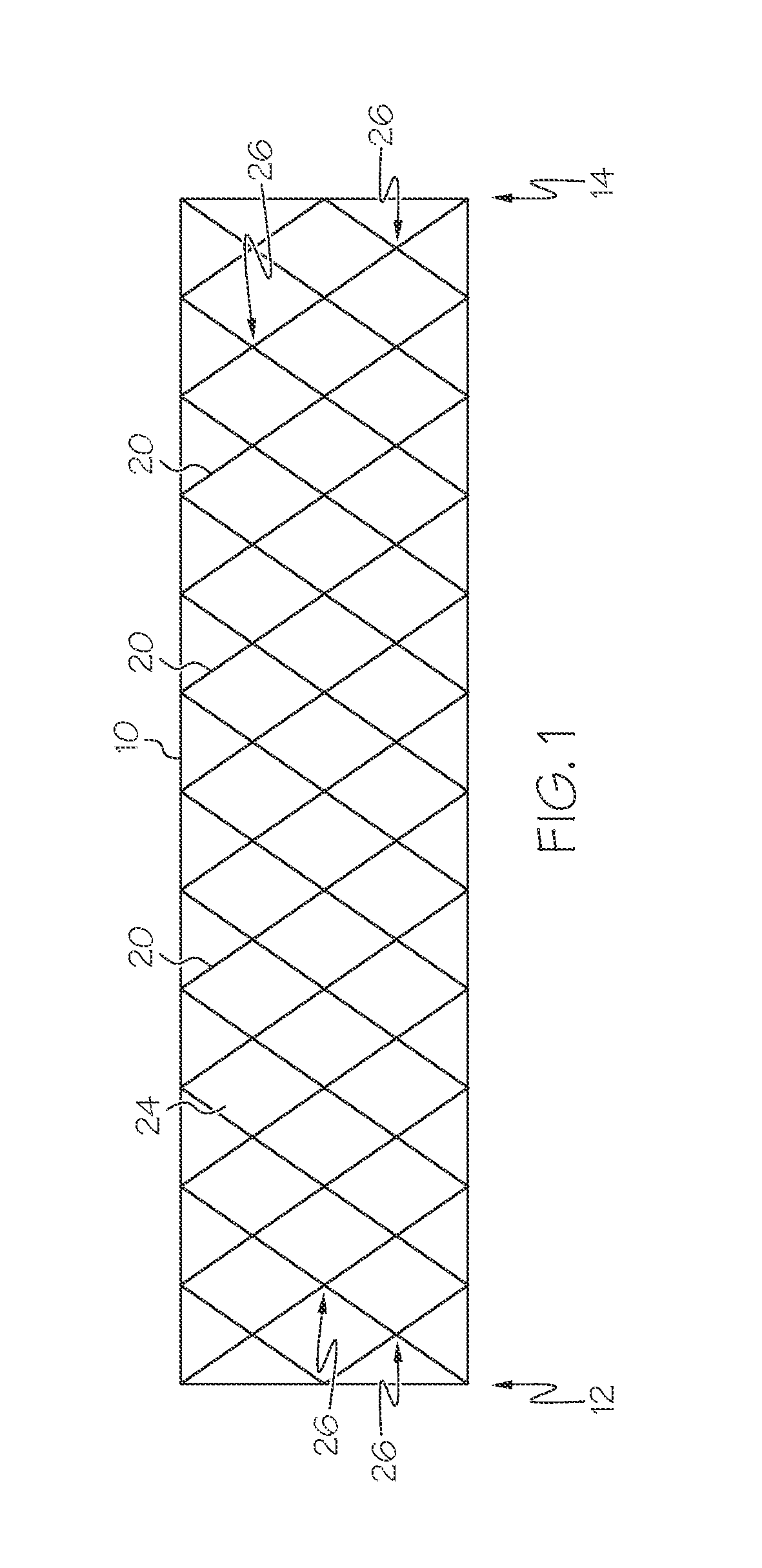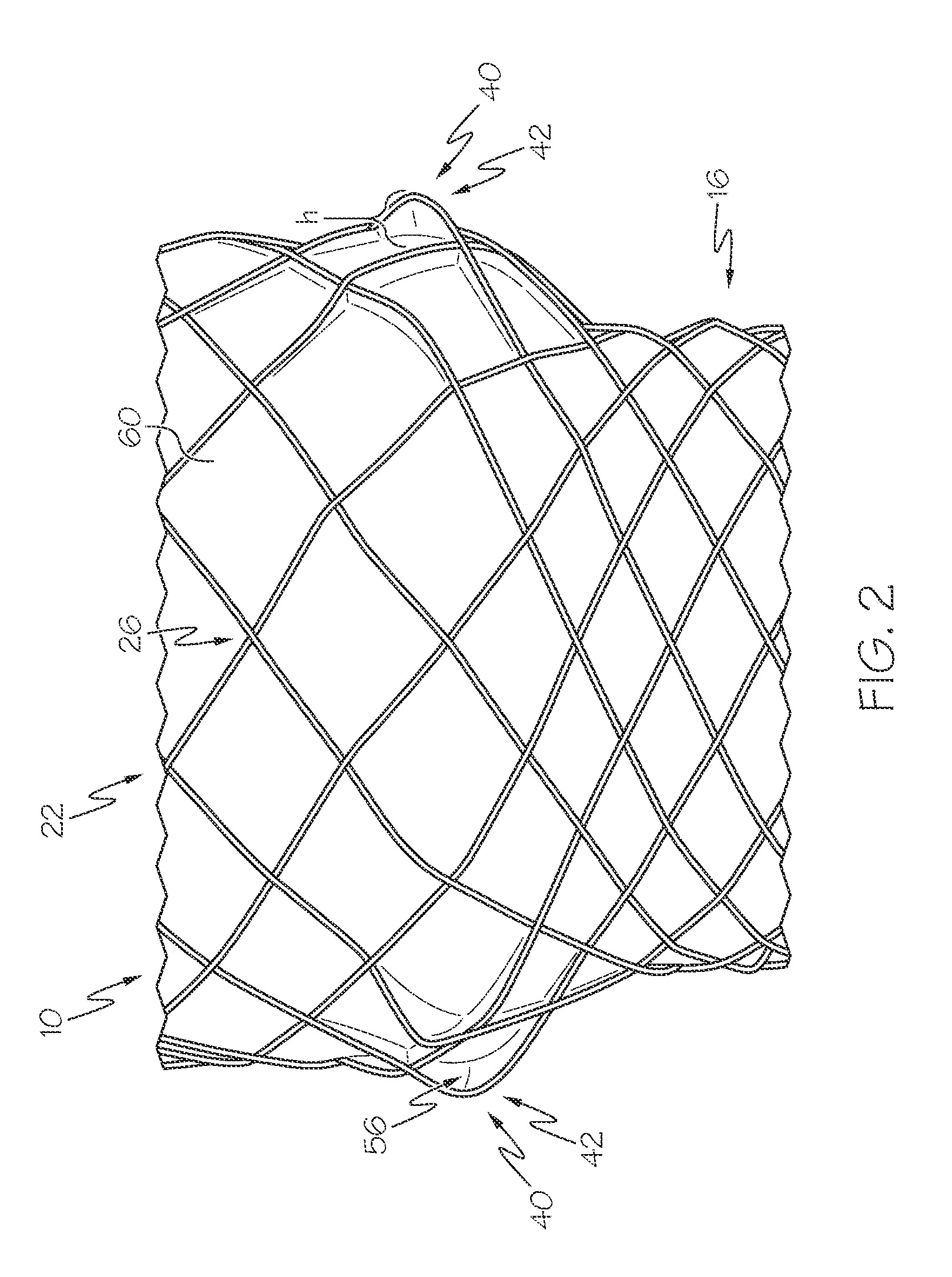Controlled ingrowth feature for antimigration
- Summary
- Abstract
- Description
- Claims
- Application Information
AI Technical Summary
Benefits of technology
Problems solved by technology
Method used
Image
Examples
example 1
[0138]FIG. 2 shows an example of a prosthesis 10 with at least protruding element 40. Specifically, the prosthesis 10 has a single layer of scaffolding 18 in the form of a mesh 22 with a protruding scaffolding filament section 42; and a cover 60.
[0139]The prosthesis has a longitudinal length of 102 mm. The end regions of the prosthesis 10 have a greater diameter than the middle region, with the end regions having a diameter of 30 mm, and the middle region having a diameter of 23 mm.
[0140]The scaffolding 18 is formed from 24 scaffolding filaments 20 each having a diameter of 0.009 mm, and comprises Nitinol. The scaffolding filaments 20 are braided at a uniform braiding angle.
[0141]The cover 60 is non-porous.
[0142]In this example, each scaffolding filament 20 with a right hand orientation has a protruding scaffolding filament section 42 extending between two scaffolding filament crossings 26 immediately adjacent one another, and each protruding scaffolding filament section 42 has a cl...
example 2
[0143]FIG. 9 shows another example of a prosthesis 10 with at least one controlled tissue ingrowth feature 40. Specifically, the prosthesis 10 has a single layer of scaffolding 18 in the form of a mesh 22 with two protruding mesh regions 44a, 44b; and a cover 60.
[0144]The prosthesis 10 has a diameter of 23 mm and a longitudinal length of 150 mm. The prosthesis 10 may have a uniform diameter except for the protruding mesh regions 44. However, the ends of the prosthesis, not shown in FIG. 9, may have a greater diameter than the uniform diameter section shown in FIG. 9. The scaffolding 18 is formed from 24 scaffolding filaments 20 each having a diameter of 0.008 mm and comprises Nitinol.
[0145]The cover 60 is non-porous and has a thickness of 40 μm.
[0146]Each protruding mesh region 44a, 44b forms a circumferential ring that extends around the entire circumference of the prosthesis; has a gap height h of 1 mm; and a longitudinal distance d of 10 mm. A longitudinal distance of 40 mm separ...
example 3
[0147]FIG. 10 shows another example of a prosthesis 10 with at least one protruding element 40. The prosthesis 10 shown in FIG. 10 is constructed and arranged for implantation in the esophagus.
[0148]The prosthesis has a longitudinal length, and prosthesis end regions with a greater diameter than the prosthesis middle region.
[0149]The prosthesis 10 has a single layer of scaffolding 18 consisting of rings 28 with protruding ring turns 46; and a cover 60.
[0150]The prosthesis 10 has rings 28 with protruding ring turns 46. Half of the rings 28 have protruding ring turns 46 oriented towards the second prosthesis end 14, and half of the rings 28 have protruding ring turns 46 oriented towards the first prosthesis end 12. Adjacent rings 28 are separated by a uniform longitudinal distance 34.
[0151]The cover 60 is non-porous and comprises silicone.
PUM
 Login to View More
Login to View More Abstract
Description
Claims
Application Information
 Login to View More
Login to View More - R&D
- Intellectual Property
- Life Sciences
- Materials
- Tech Scout
- Unparalleled Data Quality
- Higher Quality Content
- 60% Fewer Hallucinations
Browse by: Latest US Patents, China's latest patents, Technical Efficacy Thesaurus, Application Domain, Technology Topic, Popular Technical Reports.
© 2025 PatSnap. All rights reserved.Legal|Privacy policy|Modern Slavery Act Transparency Statement|Sitemap|About US| Contact US: help@patsnap.com



